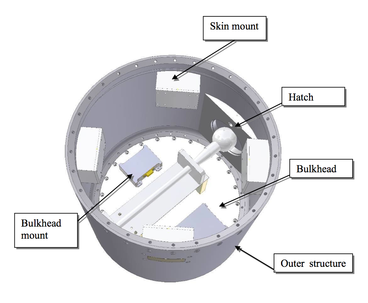Rocket
The REXUS vehicle is an unguided spin-stabilised solid propellant single-stage rocket. It is composed of an Improved Orion motor with exhaust nozzle extension, a tailcan, three stabilizing fins, a motor adapter with an integrated separation system and the payload. The standard configuration of this payload comprises the recovery module, the service system, an ejectable nosecone and experiment modules. The total mass of the rocket is around 515 kg comprising a propellant mass of 290 kg, motor and vehicle hardware of around 125 kg and a payload mass of around 100 kg. The total rocket vehicle has a length of approximately 5.6 m depending on the size of the experiments and the diameter is 356 mm. The mass of each experiment module structure and bulkhead is approximately 5 kg. The total available mass for the student experiments is about 30 kg.
This rocket gives approximately three minutes of spaceflight. For reduced microgravity conditions a de-spinning option is provided. The payload returns by a parachute system for recovery.
Download the REXUS Manual for detailed information.


Module
A typical configuration of an experiment module is shown left. Different types of mechanical interfaces between the experiment deck and the outer structure are possible. Students will be assisted to define suitable mounting positions, joints and screws for their experiment. It is a requirement that the experiment modules are either made gas tight or equipped with venting holes. For experiments requiring ejection of probes or sondes, hatches in the outer structure, are used. External cooling liquid/gas may be supplied by gas umbilical up until launch.


 "
"